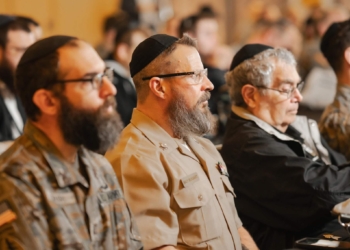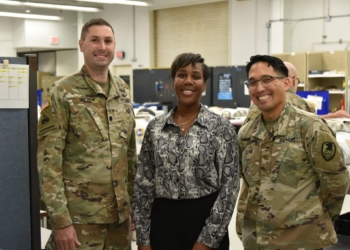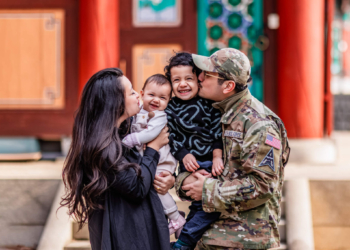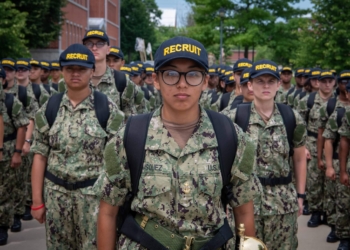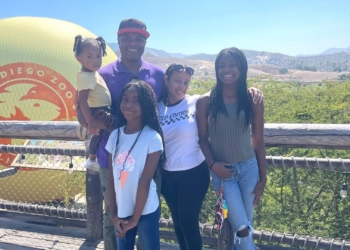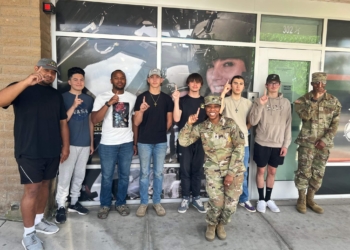On Feb. 23, 1945, then-Marine Corps Cpl. Hershel “Woody” Williams stood with his back to Mount Suribachi when his fellow Marines in the 1st Battalion, 21st Marine Regiment, 3rd Marine Division began firing their weapons in celebration. Only 5-feet 6-inches tall, Williams turned and craned his neck to see the Stars and Stripes flying atop Iwo Jima’s highest peak. The flag raising on Mount Suribachi would become the iconic image of World War II.
Two days later, Williams would etch his own name into World War II history books when the flamethrower operator cleared the enemy from inside a previously impenetrable row of “pillbox” bunkers, thwarting the U.S. military’s advance across the island.
Williams, 96, was awarded the Medal of Honor for his actions that day, but his service to his country has been lifelong. Williams was discharged from the Marine Corps in 1945, but served in the Marine Corps Reserve until his retirement. Following the war, he spent 33 years as a Veterans Service Officer within the Department of Veterans Affairs and concluded his career as commandant of the Veterans Home in Barboursville, West Virginia.
But his lasting legacy is the Hershel “Woody” Williams Medal of Honor Foundation. Established in 2012, the 501(c)(3) nonprofit has spearheaded construction of 60 Gold Star Family Memorial Monuments across the United States, with another 66 registered projects under way from New York to Guam. Each multipaneled granite monument honors the families and relatives of service members who have made the ultimate sacrifice. The organization also sponsors Gold Star family outreach programs, provides Living Legacy scholarships to eligible Gold Star children and advocates for educational benefits for all Gold Star family members.

While the history of “Gold Star mothers” dates to World War I, Gold Star families weren’t formally recognized until 2011, when President Barack Obama expanded “Gold Star Mother’s Day” to include all Gold Star family members.
“For years and years, no one spoke of a person other than Gold Star mother when somebody was lost in the military,” admits Williams, who as a teen delivered telegrams to families whose loved ones had been killed or wounded in action.
Williams received his wake-up call in 2010 after concluding a speech highlighting Gold Star mothers. The father of a soldier killed in Afghanistan approached Williams. With tears rolling down his cheeks, he told Williams, “Dads cry too.”
“I decided we had to do something, at least in our own state of West Virginia, to honor and pay tribute to the families–we’ve got 11,000 names on a veterans’ memorial in our capitol grounds,” Williams said. “We had never done anything to mention the families. I thought we had to recognize the fact they had lost a loved one.”
Williams began designing a monument to honor Gold Star families. With the assistance of Williams’ two grandsons, Bryan and Brent Casey, the foundation was established. The first Gold Star Families Memorial Monument was dedicated in 2013 on Williams’ 90th birthday at West Virginia’s Donel C. Kinnard Memorial State Veterans Cemetery. Within a year, the nation’s second Gold Star Families Monument was dedicated in Valley Forge, Pennsylvania. Other projects soon followed across the country.
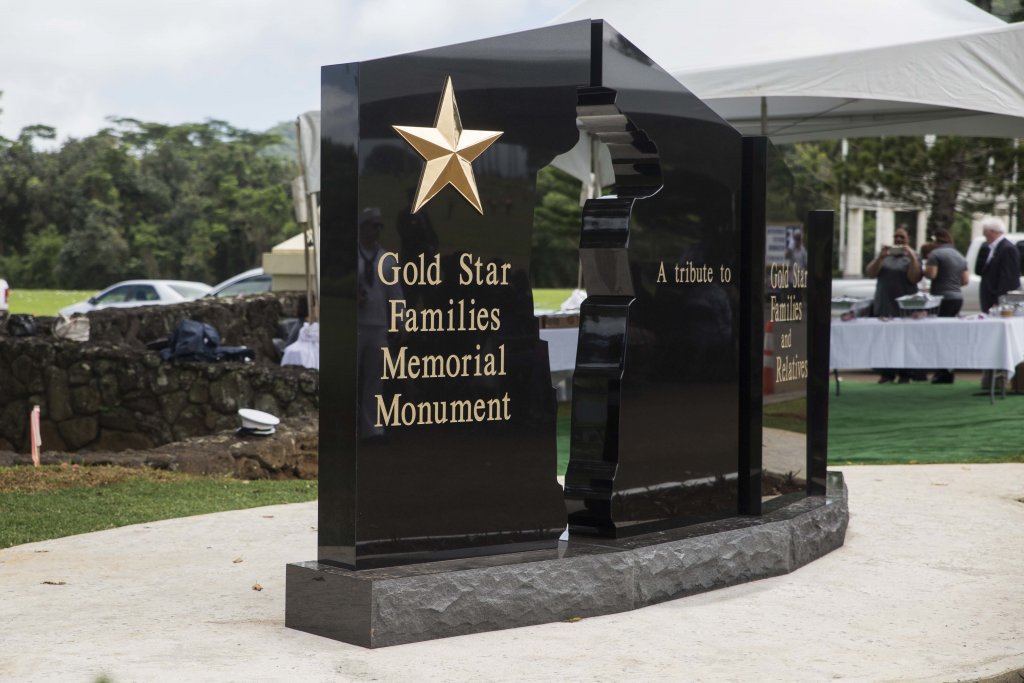
“It’s like the old saying, ‘A person dies two deaths. The day their soul leaves their body and the second when we cease to speak their name,’” said Foundation CEO and President Chad Graham, one of Williams’ five grandsons. “That’s an important part of what we do. The best way we can serve these families is not only to provide support to them, but also to remember their loved ones by saying their name and keeping their sacrifice in our minds.”
One of 11 children, Williams grew up on a dairy farm in West Virginia. When the Japanese bombed Pearl Harbor on Dec. 7, 1941, he was building fencing on government ranchland in Montana as part of the Civilian Conservation Corps. He had dropped out of high school to participate in the Depression-era public relief program.
“I was 17-years-old and had no particular interest or desire to be in the military,” Williams admits. “I knew nothing much about it. But when Pearl Harbor was bombed, they called us out the next morning and told us America was going to war. Well, none of us had ever heard of Pearl Harbor. None of us had heard of the South Pacific.”
Their fabled dress blue uniforms attracted Williams to the Marine Corps. But when he attempted to enlist after turning 18, he was rejected for failing to meet the service’s 5-feet 8-inch height requirement. When that standard was relaxed in 1943, Williams joined the Marines.

Williams saw his first combat action in the Battle of Guam in July 1944. Well-trained by combat-hardened Marines, Williams knew fear was not an option.
“If you control your fear, where it doesn’t control you, you continue to operate efficiently,” Williams explains. “But if the fear ever gets to the point where it is in control, you are done. They have to evacuate you. You’re finished. That happened to many individuals because we’re all different. One person will sacrifice his life to save somebody else, and the other guy reaches a point where he says I can’t take it anymore and leaves.”
Seven months later on Iwo Jima, a bigger challenge awaited. Williams describes his commanding officer’s decision to have a flamethrower attempt to neutralize the Japanese pillboxes as an act “bordering on desperation.” Williams volunteered, knowing he was the only flamethrower operator remaining in his company. Five others had been killed or wounded.
“That was my job. That was what I was trained to do,” Williams explains.
“Much of that day is a dream,” he adds. “Much of it I don’t even remember.”
With four riflemen — two of whom were killed during the mission — providing cover, Williams spent four hours evading enemy fire as he systematically attacked pillboxes, retreated to reload flamethrowers and demolition charges, then headed out again. All totaled, he destroyed seven pillboxes. His MOH citation cites two examples of his heroism that day: mounting a pillbox to shoot flame down the air vent and kill its occupants and charging attacking enemy soldiers and destroying them with a burst of flame.
“Those instances I remember,” he said. “But all the details it took to get there and accomplish that. Those details are not there.”
Seven months later while on Guam, Williams was ordered to his commanding general’s tent.
“I was so scared.” Williams notes. “The words I do remember are, ‘You are being ordered back to Washington, D.C.’ If he did use the words ‘Medal of Honor,’ it didn’t mean a thing because I never heard of it. I didn’t even know the Medal of Honor existed. The only thing that registered with me is I get to go home.”
Those three words, however, would alter Williams’ life. Until President Harry Truman awarded him the MOH in October 1945, Williams’ plan was to return to farming. Instead, he became a reluctant hero.
“From the minute the medal was presented to me, I took on a new life,” Williams said. “I changed from a country boy to a public figure. It was very difficult for me to make that adjustment. I was very shy, very bashful, backward. I had one year of high school. Speaking before groups of people was absolutely devastating.”
That would change as Williams became an advocate for veterans in West Virginia and throughout the nation. Since the founding of his foundation, Williams has attended nearly every Gold Star Families Monument dedication — 57 of 60 to date. He spent 220 days on the road last year in support of Gold Star family and veterans causes.
On March 7, the last living MOH recipient from the Pacific Theater will travel to Norfolk, Va., for another seminal event, the commissioning of the USS Hershel “Woody” Williams (ESB-4), an Expeditionary Sea Base Ship.
“A country boy from West Virginia that never dreamed of ever being in public has a ship that weighs 90,000 tons, that’s 10-stories tall, 825 feet long, that’s going to carry helicopters and all kinds of armaments and sail our seven seas with his name on it,” Williams said. “How can that happen to a little guy like me? Yet it does happen in America, because that’s America.”
Williams will wear his MOH when he attends the commission. While most recipients don’t shine their medals, Williams polishes his.
“I shine it for a reason,” he said. “I keep it shined for those two Marines that sacrificed their lives to make it possible. I wear it in their honor.”
















